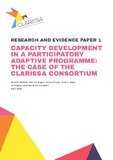| dc.contributor.author | Widmer, Mireille | |
| dc.contributor.author | Apgar, Marina | |
| dc.contributor.author | Afroze, Jiniya | |
| dc.contributor.author | Malla, Sudhir | |
| dc.contributor.author | Healey, Jill | |
| dc.contributor.author | Constant, Sendrine | |
| dc.date.accessioned | 2022-04-25T10:25:54Z | |
| dc.date.available | 2022-04-25T10:25:54Z | |
| dc.date.issued | 2022-04-25 | |
| dc.identifier.citation | Widmer, M.; Apgar, M.; Afroze, J.; Malla, S.; Healey, J. and Constant, S. (2022) Capacity Development in a Participatory Adaptive Programme: The Case of the CLARISSA Consortium, CLARISSA Research and Evidence Paper 1, Brighton: Institute of Development Studies, DOI: 10.19088/CLARISSA.2022.001 | en |
| dc.identifier.uri | https://opendocs.ids.ac.uk/opendocs/handle/20.500.12413/17351 | |
| dc.description.abstract | Doing development differently rests on deliberate efforts to reflect and learn, not just about what programmes are doing and achieving, but about how they are working. This is particularly important for an action research programme like Child Labour: Action- Research-Innovation in South and South-Eastern Asia (CLARISSA), which is implemented by a consortium of organisations from across the research and development spectrum, during a rapidly changing global pandemic. Harnessing the potential of diverse skills and complementary strengths across partners in responding to the complex challenge of the worst forms of child labour, requires capacity to work together in novel ways.
This Research and Evidence Paper documents how CLARISSA approached capacity development, and what we learnt from our challenges and successes. From the start, the programme incorporated a capacity development strategy resting on self-assessment of a wide range of behavioural and technical competencies that were deemed important for programme implementation, formal training activities, and periodic review of progress through an after-action review (AAR) process. An inventory of capacity development activities that took place during the first year of implementation reveals a wide range of additional, unplanned activities, enabled by the programme’s flexibility and adaptive management strategy. These are organised into eight modalities, according to the individual or collective nature of the activity, and its sequencing – namely, whether capacity development happens prior to, during, or after (from) implementation. We conclude with some reflections on the emergent nature of capacity development. Planning capacity development in an adaptive programme provides a scaffolding in terms of time, resources, and legitimacy that sustains adaptiveness. We also recognise the gaps that remain to be addressed, particularly on scaling up individual learning to collective capabilities, and widening the focus from implementation teams to individuals working at consortium level. | en |
| dc.language.iso | en | en |
| dc.publisher | Institute of Development Studies | en |
| dc.relation.ispartofseries | CLARISSA Research and Evidence Paper;1 | |
| dc.rights.uri | http://creativecommons.org/licenses/by/4.0/ | en |
| dc.title | Capacity Development in a Participatory Adaptive Programme: the Case of the Clarissa Consortium | en |
| dc.type | Series paper (non-IDS) | en |
| dc.rights.holder | © Institute of Development Studies | en |
| dc.identifier.doi | 10.19088/CLARISSA.2022.001 | |
| rioxxterms.funder | Department for International Development, UK Government | en |
| rioxxterms.identifier.project | CLARISSA | en |
| rioxxterms.version | VoR | en |
| rioxxterms.versionofrecord | 10.19088/CLARISSA.2022.001 | en |
| rioxxterms.funder.project | 72238f40-e8c4-4e20-a724-1ad49f5d3f6c | en |


